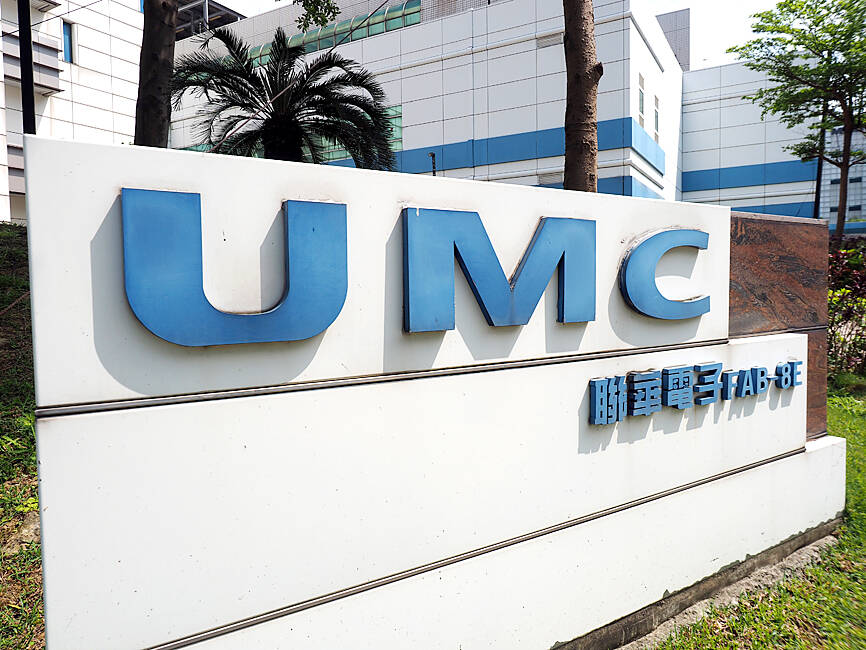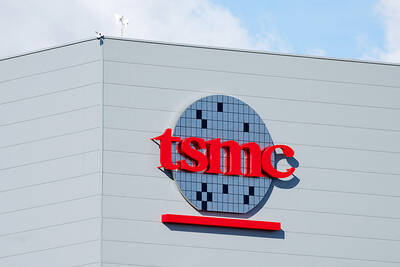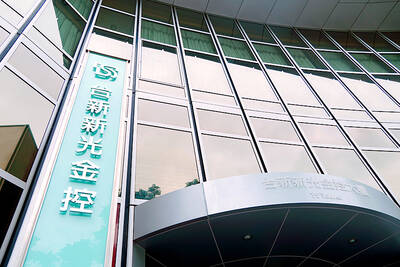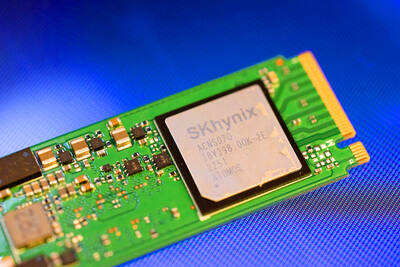United Microelectronics Corp (UMC, 聯電), the world’s No. 3 contract chipmaker, yesterday projected that its factory utilization would dip further to about 65 percent this quarter, after an inventory-driven industry slump pushed its second-quarter net profit to its weakest level in eight quarters.
UMC, which has not seen its factory utilization rate fall to as low as 65 percent since the fourth quarter of 2011, said it was difficult to predict if the rate would bottom out this quarter, as customers are expected to extend inventory destocking to next quarter, while end-market demand remains sluggish.
However, the company expects utilization of its 22-nanometer and 28-nanometer process technologies to remain resilient this quarter, thanks to a broad customer base and diverse product offerings.

Photo: David Chang, EPA-EFE
UMC said it would continue to expand its 28-nanometer capacity in Tainan, as most of the capacity is covered by long-term supply agreements with customers.
“Wafer demand outlook in the third quarter is uncertain, given prolonged inventory correction in the supply chain,” UMC chief executive officer Jason Wang (王石) told investors.
Inventory digestion in the smartphone, computer and server sectors has fallen short of the company’s expectations, Wang said.
“While we saw spots of limited recovery in the second quarter, overall end-market sentiment remained weak and we expect customers to continue stringent inventory management in the near term,” he said.
UMC expects wafer shipments to drop by about 3 to 4 percent sequentially this quarter, while average selling prices would rise about 2 percent.
Gross margin this quarter would slide 1 to 3 percentage points from 36 percent last quarter due to higher manufacturing costs, including electricity, raw materials and labor.
Net profit fell 3.3 percent to NT$15.64 billion (US$500.4 million) last quarter, compared with NT$16.18 billion in the first quarter and NT$21.33 billion a year earlier.
Earnings per share dropped to NT$1.27 from NT$1.31 in the first quarter and NT$1.74 a year earlier.
UMC yesterday further revised down its forecast for world semiconductor revenue this year, projecting an annual decline of about 5 percent, instead of the drop of 1 to 3 percent it estimated in April.
The foundry sector would see an even sharper drop of 15 percent compared with its earlier estimate of a high-single-digit percentage decline this year, it said.
Nonetheless, UMC would double its silicon interposer wafer capacity, which is used in advanced chip packaging technology, by the middle of next year to cope with growing demand for artificial intelligence chips, Wang said.

Taiwan Semiconductor Manufacturing Co (TSMC, 台積電) secured a record 70.2 percent share of the global foundry business in the second quarter, up from 67.6 percent the previous quarter, and continued widening its lead over second-placed Samsung Electronics Co, TrendForce Corp (集邦科技) said on Monday. TSMC posted US$30.24 billion in sales in the April-to-June period, up 18.5 percent from the previous quarter, driven by major smartphone customers entering their ramp-up cycle and robust demand for artificial intelligence chips, laptops and PCs, which boosted wafer shipments and average selling prices, TrendForce said in a report. Samsung’s sales also grew in the second quarter, up

On Tuesday, US President Donald Trump weighed in on a pressing national issue: The rebranding of a restaurant chain. Last week, Cracker Barrel, a Tennessee company whose nationwide locations lean heavily on a cozy, old-timey aesthetic — “rocking chairs on the porch, a warm fire in the hearth, peg games on the table” — announced it was updating its logo. Uncle Herschel, the man who once appeared next to the letters with a barrel, was gone. It sparked ire on the right, with Donald Trump Jr leading a charge against the rebranding: “WTF is wrong with Cracker Barrel?!” Later, Trump Sr weighed

HEADWINDS: Upfront investment is unavoidable in the merger, but cost savings would materialize over time, TS Financial Holding Co president Welch Lin said TS Financial Holding Co (台新新光金控) said it would take about two years before the benefits of its merger with Shin Kong Financial Holding Co (新光金控) become evident, as the group prioritizes the consolidation of its major subsidiaries. “The group’s priority is to complete the consolidation of different subsidiaries,” Welch Lin (林維俊), president of the nation’s fourth-largest financial conglomerate by assets, told reporters during its first earnings briefing since the merger took effect on July 24. The asset management units are scheduled to merge in November, followed by life insurance in January next year and securities operations in April, Lin said. Banking integration,

LOOPHOLES: The move is to end a break that was aiding foreign producers without any similar benefit for US manufacturers, the US Department of Commerce said US President Donald Trump’s administration would make it harder for Samsung Electronics Co and SK Hynix Inc to ship critical equipment to their chipmaking operations in China, dealing a potential blow to the companies’ production in the world’s largest semiconductor market. The US Department of Commerce in a notice published on Friday said that it was revoking waivers for Samsung and SK Hynix to use US technologies in their Chinese operations. The companies had been operating in China under regulations that allow them to import chipmaking equipment without applying for a new license each time. The move would revise what is known